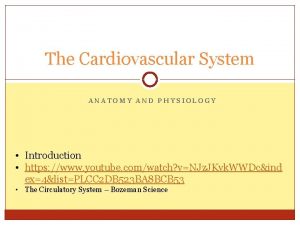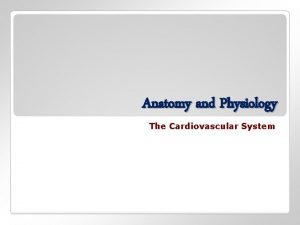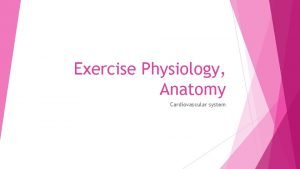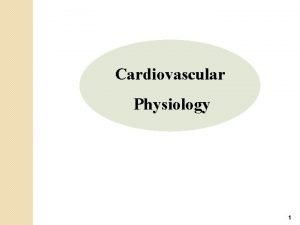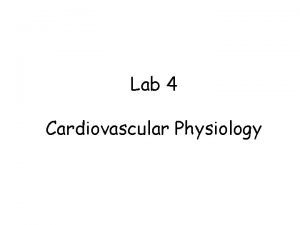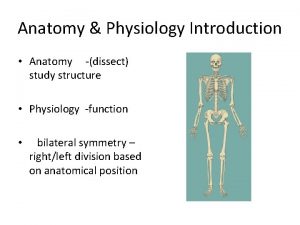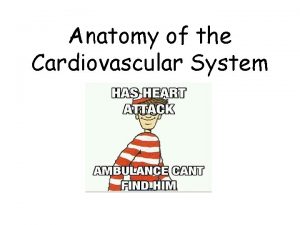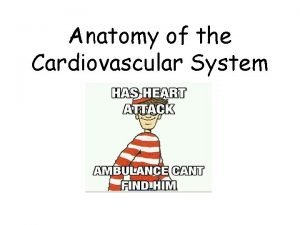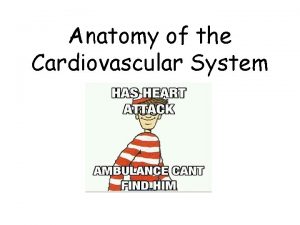The Cardiovascular System ANATOMY AND PHYSIOLOGY Introduction https





































- Slides: 37

The Cardiovascular System ANATOMY AND PHYSIOLOGY • Introduction • https: //www. youtube. com/watch? v=NJz. JKvk. WWDc&ind ex=4&list=PLCC 2 DB 523 BA 8 BCB 53 • The Circulatory System – Bozeman Science

Read & Answer (p 348 -354) Slide 1 �Approximately how big is a person’s heart? �Put the following in order from inside to outside of the heart wall. endocardium, epicardium, myocardium. Which of these contain the cardiac muscles? 350 �How many chambers make up the heart? Name them. �What is the septum? What are the other 2 names it goes by? 352 �Where is blood from the right side of the heart going? Where is blood from the left side of the heart going? �List the 4 valves in the heart and how many cusps each has. 352 -353

Define the following Slide 2 1. 2. 3. 4. 5. 6. 7. 8. 9. 10. 11. 12. Apex 349 Pericardium 349 Pulmonary circulation 352 Systemic circulation 352 Punkinje fibers 355 Sinoatrial node 355 Atrioventricular node 355 Bundle branches 355 Tachycardia 357 Bradycardia 357 Systole 357 Diastole 357 13. 14. 15. 16. 17. 18. 19. 20. Stroke volume 358 Arteries 360 Arterioles 360 capillary beds 360 Venules 360 Veins 360 Coronary arteries 364 Vasoconstriction 374

Read & Answer (p 352 -383) Slide 3 �What is cardiac output and how is it calculated? 358 �What does the sympathetic and parasympathetic activities do to the heart? 359 �Put the following in order from inside to outside of the vessels. tunica externa, tunica intima, tunica media 360362 �List 2 structural differences in veins from arteries? 362 �What vessels branch from the ascending aorta? What organ is it supplying with blood? 364 �Where are the carotid and coronary arteries located? 365 �What are the 3 vessels in the umbilical cord? What does each carry? 370

Read & Answer (p 354 -383) Slide 4 �What is a pressure point? 372 �Put the following in order from highest to lowest pressure? Arterioles, vena cava, arteries, capillaries, veins 372 �If blood vessel diameter increased, would blood pressure increase or decrease? 373 -74 �How does blood pressure and osmotic pressure influence substances moving in or out of the capillaries? Which end do substances tend to move in and which end do substances move out? 381 �What causes varicose veins? 383

Physiology of the Heart �In one day, the heart pushes the body’s 6 liters of blood through the blood vessels over 100 times �Pumps about 6000 liters of blood in a single day

Intrinsic Conduction System of the Heart �Cardiac muscles contract spontaneously and independently (even without nervous connections) �Contractions occur in a regular and continuous way �Two systems to regulate heart activity: Nerves of the autonomic nervous system Intrinsic conduction system* (next slide)

Intrinsic Conduction System of the Heart �Composed of a special tissue found nowhere else in the body �Cross between muscle and nervous tissue �Enforces a contraction rate of approximately 75 beats per minute – coordinated contractions

Intrinsic Conduction System of the Heart �Sinoatrial Node (SA node) Located in the right atrium Tiny cell mass Starts each heartbeat and sets the pace of the whole heart “pacemaker”

Intrinsic Conduction System of the Heart �Atrioventricular Node (AV node) Located at the junction of the atria and ventricles Receives the impulse from the SA node Atria contract Impulse is delayed to allow the atria to finish contracting

Intrinsic Conduction System of the Heart �Atrioventricular Bundle (AV bundle) Located in the septum Receives the impulse from the AV node after the delay Results in the contraction of the ventricles that begins at the apex and moves toward the atria Contraction ejects blood into the large arteries leaving the heart

Intrinsic Conduction System of the Heart

Heart Rate �Tachycardia Rapid heart rate Over 100 beats per minute Prolonged tachycardia may progress to fibrillation �Bradycardia Slow heart rate Less than 60 beats per minute

Cardiac Cycle and Heart Sounds �Healthy Heart Cycle: Atria contract simultaneously As they relax, the ventricles begin to contract �Vocabulary: Systole – contraction Diastole - relaxation

Cardiac Cycle and Heart Sounds �Cardiac Cycle – the events of one complete heartbeat �Approximately 0. 8 seconds � 3 Periods: Mid-to-late diastole Ventricular systole Early diastole �https: //www. youtube. com/watch? v=j. LTdgrhp. DCg Cardiac Cycle - Systole & Diastole �https: //www. youtube. com/watch? v=5 t. UWOF 6 w. Enk The cardiac cycle

Cardiac Cycle and Heart Sounds �Mid-to-Late Diastole Heart is completely relaxed Pressure in the heart is low Blood is flowing passively into and through the atria Semilunar valves are closed AV valves are open Atria contract � Force the remaining blood in their chambers into the ventricles

Cardiac Cycle and Heart Sounds �Ventricular Systole Ventricular contraction begins Pressure within the ventricles increases rapidly, closing the AV valves Semilunar valves force open Blood rushes out of the heart through the large arteries leaving the heart Atria are relaxed and are filling with blood

Cardiac Cycle and Heart Sounds �Early Diastole Ventricles relax Semilunar valves shut, preventing backflow Intraventricular pressure drops AV valves open

Cardiac Cycle and Heart Sounds �Lub, dup, pause Lub – closing of the AV valves Dup – seminlunar valves close �First sound is longer and louder than the second

Cardiac Output �The amount of blood pumped out by each side of the heart in 1 minute �Product of the heart rate (HR) and stroke volume (SV) �SV – the volume of blood pumped out by a ventricle with each heartbeat �Average cardiac output = 5250 m. L/min

Regulation of Stroke Volume �Anything that increases the volume or speed of venous return increases stroke volume and force of contraction Exercise, slow heartbeat �Anything decreasing stroke volume causes the heart to beat less forcefully Blood loss, extremely rapid heart rate

Factors Modifying Basic Heart Rate �Emotional or physical stress �Age �Gender �Exercise �Body temperature

Average Heart Rate �Fetus: 140 -160 beats per minute �Adult Females: 72 -80 beats per minute �Adult Males: 64 -72 beats per minute

Fetal Circulation �Lungs and digestive system not functional in the fetus �All nutrients, excretory, and gas exchange occurs through the placenta �Nutrients and oxygen move from the mother’s blood to the fetal blood �Fetal waste goes in the opposite direction �https: //www. youtube. com/watch? v=f 4 SGBSe. Fwvg fetal circulation

Fetal Circulation

Physiology of Circulation �Vital Signs Arterial pulse* Blood pressure* Respiratory rate Body temperature

Physiology of Circulation �Arterial Pulse Caused by expansion and recoil of an artery Normally equals the heart rate (70 -76 per minute resting) Can be felt in arteries lying close to the body surface Most common: radial pulse

Physiology of Circulation

Physiology of Circulation �Blood Pressure The pressure the blood exerts against the inner walls of the blood vessels The force that keeps blood circulating continuously

Physiology of Circulation �Blood Pressure Gradient Highest pressure – largest arteries Pressure drops to zero or negative pressure at the vena cavae Example � cut vein – blood flows from the wound � cut artery – blood spurts from the wound

Physiology of Circulation �Measuring Blood Pressure Systolic pressure � The Diastolic pressure � The pressure in the arteries at the peak of ventricular contraction pressure when the ventricles are relaxing Measurements � Units – mm. Hg � Systolic over diastolic � Example: 120/80

Physiology of Circulation �Variations in Blood Pressure Systolic: 110 -140 mm. Hg Diastolic: 75 -80 Varies considerably from person to person Factors Affecting Blood Pressure: � Age, weight, race, mood, physical activity, and posture Conditions: � Hypotension: low blood pressure (below 100 mm. Hg) � Hypertension: high blood pressure(above 140/90 mm. Hg)

Capillary Exchange of Gases and Nutrients �Substances tend to move to and from body cells according to their concentration gradients �Oxygen and nutrients leave the blood and enter the tissue cells �Carbon dioxide and other wastes exit the tissue cells and enter the blood

Capillary Exchange of Gases and Nutrients �Four routes across the capillary wall: Diffusion across the plasma membrane – lipid soluble Endocytosis or exocytosis – enter/leave in vesicles Intercellular clefts – areas of the plasma membrane not joined by tight junctions Fenestrated capillaries: pores in capillary wall covered by very permeable membrane

Crash Course – The Heart �https: //www. youtube. com/watch? v=X 9 ZZ 6 tcx. Ar. I&i ndex=25&list=PL 8 d. Puua. Lj. Xt. OAKed_Mxx. WBNa. Pn o 5 h 3 Zs 8 � The Heart, part 1 - Under Pressure: Crash Course A&P #25

Crash Course – Blood Vessels (extras) � https: //www. youtube. com/watch? v=v 43 ej 5 l. Ce. Bo&index=2 7&list=PL 8 d. Puua. Lj. Xt. OAKed_Mxx. WBNa. Pno 5 h 3 Zs 8 � Blood Vessels, part 1 - Form and Function: Crash Course A&P #27 � https: //www. youtube. com/watch? v=ZVkl. Pw. GALp. I&index =28&list=PL 8 d. Puua. Lj. Xt. OAKed_Mxx. WBNa. Pno 5 h 3 Zs 8 � Blood Vessels, part 2: Crash Course A&P #28

Heart Attack �https: //www. youtube. com/watch? v=T 8 zkvdkz. U 7 A Heart attack in 3 d animation (4 min) � https: //www. youtube. com/watch? v=H_Vs. Hmo. RQKk&ebc=ANy. Px. Kr. BC- 6 df. V 3 j 4 ca. Kz. RD 29 Ks. YRY 0 hw 2 Ab. TR 21 RV 6 w. Hf. Kn. RXHTJMmkz 1 qufzf. Zwl. WYu x 0 Hi. F 9 UT-X 7 p. Kzc 6 B 3 h 979 Jy. M 646 A What happens during a Heart Attack? (10 min)
 Anatomy and physiology unit 7 cardiovascular system
Anatomy and physiology unit 7 cardiovascular system Waistline
Waistline Chapter 1 introduction to human anatomy and physiology
Chapter 1 introduction to human anatomy and physiology Chapter 1 an introduction to anatomy and physiology
Chapter 1 an introduction to anatomy and physiology Respiratory system in humans
Respiratory system in humans Appendicular skeleton pectoral girdle
Appendicular skeleton pectoral girdle Introduction of heart
Introduction of heart Upper respiratory tract
Upper respiratory tract Tattoo anatomy and physiology
Tattoo anatomy and physiology Anatomy science olympiad
Anatomy science olympiad Structure anatomy and physiology in agriculture
Structure anatomy and physiology in agriculture Bone anatomy and physiology
Bone anatomy and physiology Pud triple therapy
Pud triple therapy Liver physiology and anatomy
Liver physiology and anatomy Podbřišek
Podbřišek Wpigastric region
Wpigastric region Red blood cells anatomy and physiology
Red blood cells anatomy and physiology The central sulcus divides which two lobes? (figure 14-13)
The central sulcus divides which two lobes? (figure 14-13) Human anatomy and physiology seventh edition marieb
Human anatomy and physiology seventh edition marieb Http://anatomy and physiology
Http://anatomy and physiology Physiology of appendicitis
Physiology of appendicitis Aohs foundations of anatomy and physiology 1
Aohs foundations of anatomy and physiology 1 Aohs foundations of anatomy and physiology 2
Aohs foundations of anatomy and physiology 2 Anatomical planes
Anatomical planes Anatomy and physiology chapter 8 special senses
Anatomy and physiology chapter 8 special senses Chapter 13 anatomy and physiology of pregnancy
Chapter 13 anatomy and physiology of pregnancy Teks anatomy and physiology
Teks anatomy and physiology Science olympiad anatomy and physiology 2020 cheat sheet
Science olympiad anatomy and physiology 2020 cheat sheet Chapter 2 basic chemistry anatomy and physiology
Chapter 2 basic chemistry anatomy and physiology Stomach anatomy and physiology ppt
Stomach anatomy and physiology ppt Pancreas anatomy and physiology
Pancreas anatomy and physiology Heat and cold
Heat and cold Chapter 14 the digestive system and body metabolism
Chapter 14 the digestive system and body metabolism Chapter 10 blood anatomy and physiology
Chapter 10 blood anatomy and physiology Aohs foundations of anatomy and physiology 1
Aohs foundations of anatomy and physiology 1 Aohs foundations of anatomy and physiology 1
Aohs foundations of anatomy and physiology 1 Anatomy and physiology
Anatomy and physiology Anatomy and physiology chapter 15
Anatomy and physiology chapter 15








































